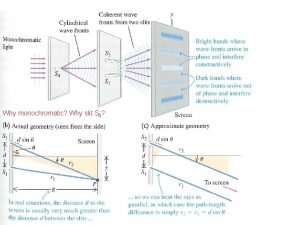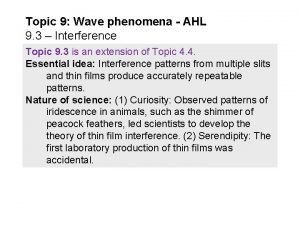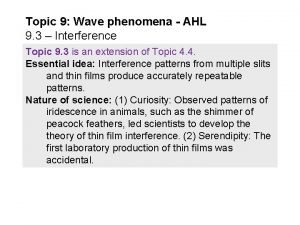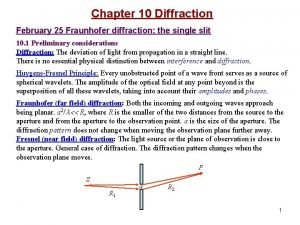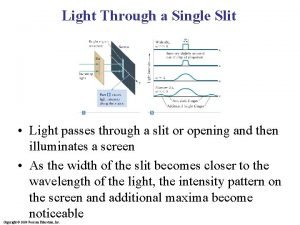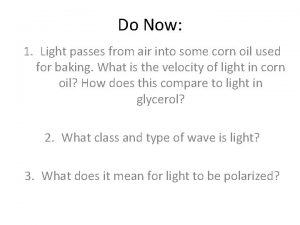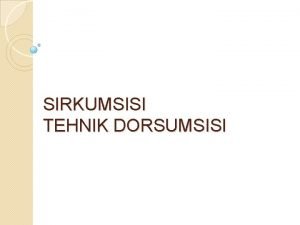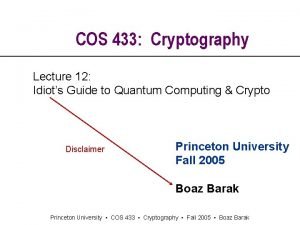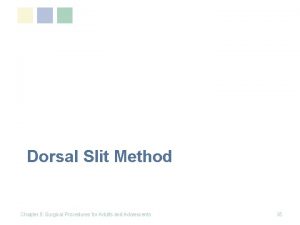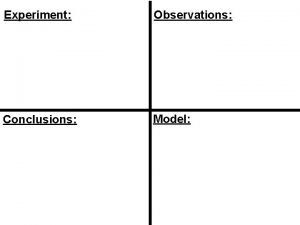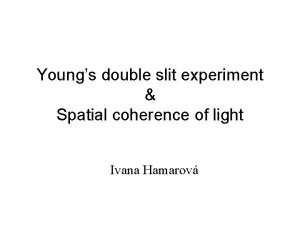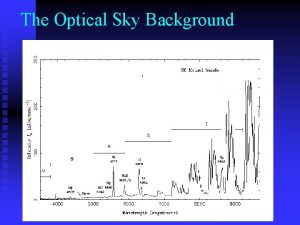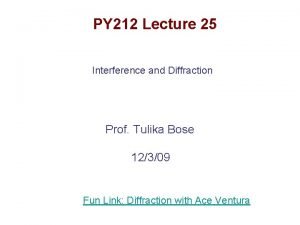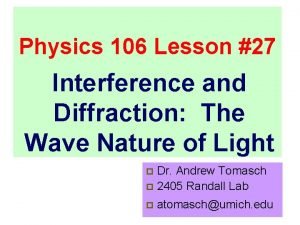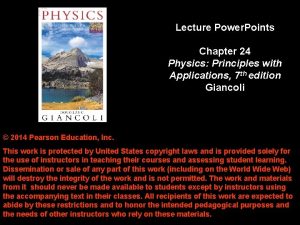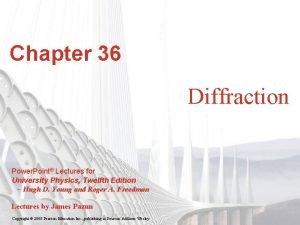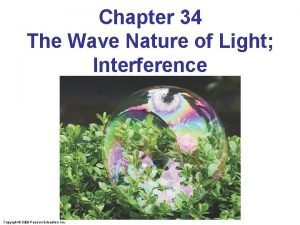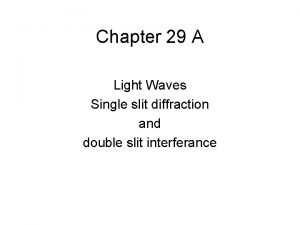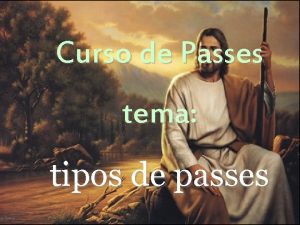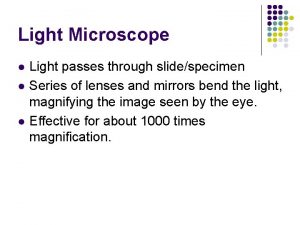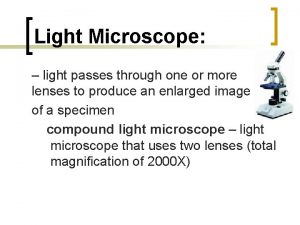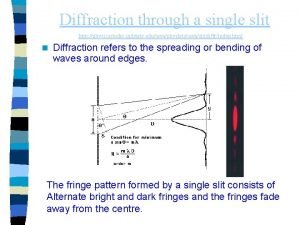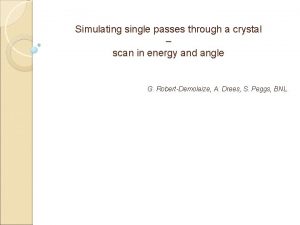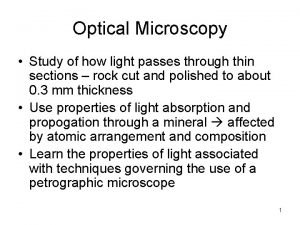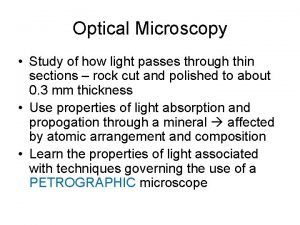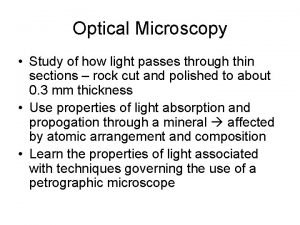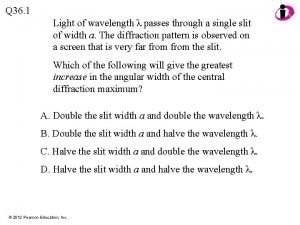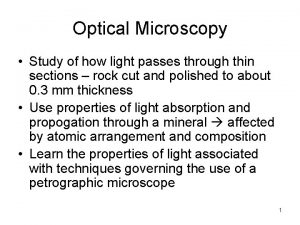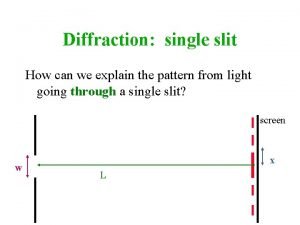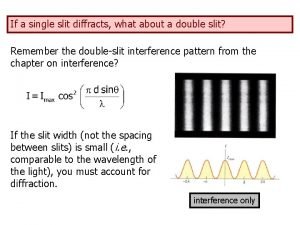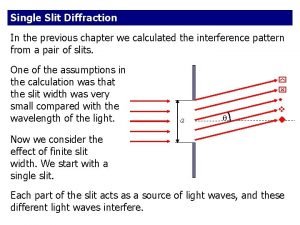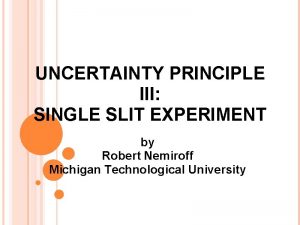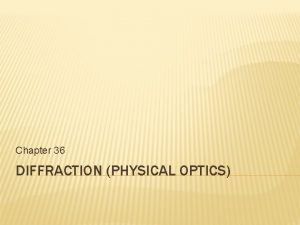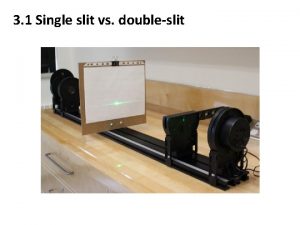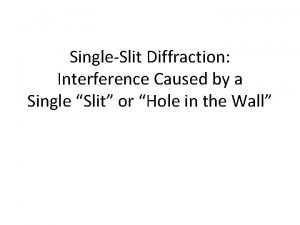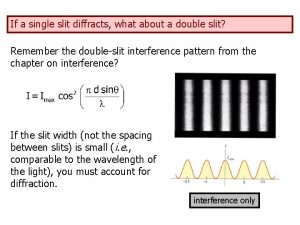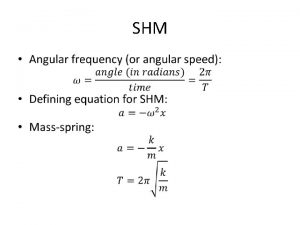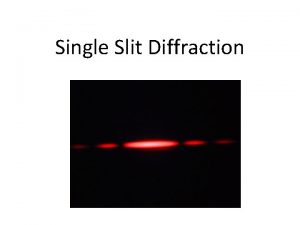Light Through a Single Slit Light passes through








































- Slides: 40

Light Through a Single Slit • Light passes through a slit or opening and then illuminates a screen • As the width of the slit becomes closer to the wavelength of the light, the intensity pattern on the screen and additional maxima become noticeable Copyright © 2009 Pearson Education, Inc.

Single-Slit Diffraction • Water wave example of single-slit diffraction – All types of waves undergo single-slit diffraction – Water waves have a wavelength easily visible • Diffraction is the bending or spreading of a wave when it passes through an opening Copyright © 2009 Pearson Education, Inc.

Huygen’s Principle • It is useful to draw the wave fronts and rays for the incident and diffracting waves • Huygen’s Principle can be stated as all points on a wave front can be thought of as new sources of spherical waves Copyright © 2009 Pearson Education, Inc.

Double-Slit Interference • Light passes through two very narrow slits • When the two slits are both very narrow, each slit acts as a simple point source of new waves • The outgoing waves from each slit are like simple spherical waves • The double slit experiment showed conclusively that light is a wave • Experiment was first carried out by Thomas Young around 1800 Copyright © 2009 Pearson Education, Inc.

Young’s Double-Slit Experiment • Light is incident onto two slits and after passing through them strikes a screen • The light intensity on the screen shows an interference pattern Copyright © 2009 Pearson Education, Inc.

Young’s Experiment, cont. • The experiment satisfies the general requirements for interference – The interfering waves travel through different regions of space as they travel through different slits – The waves come together at a common point on the screen where they interfere – The waves are coherent because they come from the same source • Interference will determine how the intensity of light on the screen varies with position Copyright © 2009 Pearson Education, Inc.

Young’s Experiment • Assume the slits are very narrow • According the Huygen’s principle, each slit acts as a simple source with circular wave fronts as viewed from above • The light intensity on the screen alternates between bright and dark as you move along the screen – These areas correspond to regions of constructive interference and destructive interference Copyright © 2009 Pearson Education, Inc.

Double Slit Analysis • Need to determine the path length between each slit and the screen • Assume W is very large • If the slits are separated by a distance d, then the difference in length between the paths of the two rays is ΔL = d sin θ Copyright © 2009 Pearson Education, Inc.

Double Slit Analysis • If ΔL is equal to an integral number of complete wavelengths, then the waves will be in phase when they strike the screen – The interference will be constructive – The light intensity will be large • If ΔL is equal to a half number of complete wavelengths, then the waves will not be in phase when they strike the screen – The interference will be destructive – The light intensity will be zero Copyright © 2009 Pearson Education, Inc.

Conditions for Interference • For constructive interference, d sin θ = m λ – m = 0, ± 1, ± 2, … – Will observe a bright fringe • For destructive interference, d sin θ = (m + ½) λ – m = 0, ± 1, ± 2, … – Will observe a dark fringe Copyright © 2009 Pearson Education, Inc.

Double-Slit Intensity Pattern • The angle θ varies as you move along the screen • Each bright fringe corresponds to a different value of m • Negative values of m indicate that the path to those points on the screen from the lower slit is shorter than the path from the upper slit Copyright © 2009 Pearson Education, Inc.

Spacing Between Slits • Notation: – d is the distance between the slits – W is the distance between the slits and the screen – h is the distance between the adjacent bright fringes • For m = 1, • Since the angle is very small, sin θ ~ θ and θ ~ λ/d • Between m = 0 and m = 1, h = W tan θ Copyright © 2009 Pearson Education, Inc.

Approximations • Since the wavelength of light is small, the angles involved in the double-slit analysis are also small • For small angles, tan θ ~ θ and sin θ ~ θ • Using the approximations, h = W θ = W λ / d Copyright © 2009 Pearson Education, Inc.

Interference with Monochromatic Light • The conditions for interference state the interfering waves must have the same frequency – This means they must have the same wavelength • Light with a single frequency is called monochromatic (one color) • Light sources with a variety of wavelengths are generally not useful for double-slit interference experiments – The bright and dark fringes may overlap or the total pattern may be a “washed out” sum of bright and dark regions – No bright or dark fringes will be visible Copyright © 2009 Pearson Education, Inc.

Single-Slit Interference • Slits may be narrow enough to exhibit diffraction but not so narrow that they can be treated as a single point source of waves • Assume the single slit has a width, w • Light is diffracted as it passes through the slit and then propagates to the screen Copyright © 2009 Pearson Education, Inc.

Single-Slit Analysis • The key to the calculation of where the fringes occur is Huygen’s principle • All points across the slit act as wave sources • These different waves interfere at the screen • For analysis, divide the slit into two parts Copyright © 2009 Pearson Education, Inc.

Single-Slit Fringe Locations • If one point in each part of the slit satisfies the conditions for destructive interference, the waves from all similar sets of points will also interfere destructively • Destructive interference will produce a dark fringe Copyright © 2009 Pearson Education, Inc.

Single-Slit Analysis: Dark Fringers • Conditions for destructive interference are w sin θ = ±m λ – m = 1, 2, 3, … – The negative sign will correspond to a fringe below the center of the screen Copyright © 2009 Pearson Education, Inc.

Single-Slit Analysis: Bright Fringes • There is no simple formula for the angles at which the bright fringes occur • The intensity on the screen can be calculated by adding up all the Huygens waves • There is a central bright fringe with other bright fringes that are lower in intensity – The central fringe is called the central maximum – The central fringe is about 20 times more intense than the bright fringes on either side – The width of the central bright fringe is approximately the angular separation of the first dark fringes on either side Copyright © 2009 Pearson Education, Inc.

Single-Slit – Central Maximum • The full angular width of the central bright fringe = 2 λ / w • If the slit is much wider than the wavelength, the light beam essentially passes straight through the slit with almost no effect from diffraction Copyright © 2009 Pearson Education, Inc.

Double-Slit Interference with Wide Slits • When the slits of a double-slit experiment are not extremely narrow, the single-slit diffraction pattern produced by each sit is combined with the sinusoidal double-slit interference pattern • A full calculation of the intensity pattern is very complicated Copyright © 2009 Pearson Education, Inc.

Diffraction Grating • An arrangement of many slits is called a diffraction grating • Assumptions – The slits are narrow • Each one produces a single outgoing wave – The screen is very far away Copyright © 2009 Pearson Education, Inc.

Diffraction Grating • Since the screen is far away, the rays striking the screen are approximately parallel – All make an angle θ with the horizontal axis • If the slit-to-slit spacing is d, then the path length difference for the rays from two adjacent slits is ΔL = d sin θ • If ΔL is equal to an integral number of wavelengths, constructive interference occurs • For a bright fringe, d sin θ = m λ – m = 0, ± 1, ± 2, … Copyright © 2009 Pearson Education, Inc.

Diffraction Grating, final • The condition for bright fringes from a diffraction grating is identical to the condition for constructive interference from a double slit • The overall intensity pattern depends on the number of slits • The larger the number of slits, the narrower the peaks Copyright © 2009 Pearson Education, Inc.

Grating and Color Separation • A diffraction grating will produce an intensity pattern on the screen for each color • The different colors will have different angles and different places on the screen • Diffraction gratings are widely used to analyze the colors in a beam of light Copyright © 2009 Pearson Education, Inc.

Diffraction and CDs • Light reflected from the arcs in a CD acts as sources of Huygens waves • The reflected waves exhibit constructive interference at certain angles • Light reflected from a CD has the colors “separated” Copyright © 2009 Pearson Education, Inc.

Crystal Diffraction of X-rays • Diffraction effects occur with other types of waves • The atoms of a crystal are arranged in a periodic way, forming planes • These planes reflect em radiation • Leads to interference of the reflected rays Copyright © 2009 Pearson Education, Inc.

X-Ray Diffraction, cont. • The effective slit spacing is the distance between atomic planes – Typically 3 x 10 -10 m – Compared to 10 -4 m or 10 -5 m for a grating • X-rays have the appropriate wavelength to diffract – The planes give dots instead of fringes • By measuring the angles that give constructive interference, the distance between the planes can be measured Copyright © 2009 Pearson Education, Inc.

Optical Resolution • For a circular opening of diameter D, the angle between the central bright maximum and the first minimum is – The circular geometry leads to the additional numerical factor of 1. 22 Copyright © 2009 Pearson Education, Inc.

Telescope Example • • • Assume you are looking at a star through a telescope Diffraction at the opening produces a circular diffraction spot Assume there actually two stars The two waves are incoherent and do not interfere Each source produces its own different pattern Copyright © 2009 Pearson Education, Inc.

Rayleigh Criterion • If the two sources are sufficiently far apart, they can be seen as two separate diffraction spots (A) • If the sources are too close together, their diffraction spots will overlap so much that they appear as a single spot (C) Copyright © 2009 Pearson Education, Inc.

Rayleigh Criterion, cont. • Two sources will be resolved as two distinct sources of light if their angular separation is greater than the angular spread of a single diffraction spot • This result is called the Rayleigh criterion • For a circular opening, the Rayleigh criterion for the angular resolution is • Two objects will be resolved when viewed through an opening of diameter D if the light rays from the two objects are separated by an angle at least as large as θmin Copyright © 2009 Pearson Education, Inc.

Limits on Focusing • A perfect lens will focus a narrow parallel beam of light to a precise point at the focal point of the lens • The ray optics approximation ignores diffraction • The real focus is spread over a disc Copyright © 2009 Pearson Education, Inc.

Limits on Focusing, cont. • If the lens has a diameter D, it acts like an opening and according to the Rayleigh criterion produces a diffracted beam spread over a range of angles • Diffraction spreads the focal point over a disk of radius r • • The focal length is limited to Copyright © 2009 Pearson Education, Inc.

Limits on Focusing, final • The wave nature of light limits the focusing qualities of even a perfect lens • It is not possible to focus a beam of light to a spot smaller than approximately the wavelength • The ray approximation of geometrical optics can be applied at size scale much greater than the wavelength • When a slit or a focused beam of light is made so small that its dimensions are comparable to the wavelength, diffraction effects become important Copyright © 2009 Pearson Education, Inc.

Scattering • When the wavelength is larger than the reflecting object, the reflected waves travel away in all direction and are called scattered waves • The amplitude of the scattered wave depends on the size of the scattering object compared to the wavelength • Blue light is scattered more than red – Called Rayleigh scattering Copyright © 2009 Pearson Education, Inc.

Blue Sky • The light we see from the sky is sunlight scattered by the molecules in the atmosphere • The molecules are much smaller than the wavelength of visible light – They scatter blue light more strongly than red – This gives the atmosphere its blue color Copyright © 2009 Pearson Education, Inc.

Scattering, Sky, and Sun • Blue sky – Although violet scatters more than blue, the sky appears blue – The Sun emits more strongly in blue than violet – Our eyes are more sensitive to blue – The sky appears blue even though the violet light is scattered more • Sun near horizon – There are molecules to scatter the light – Most of the blue is scattered away, leaving the red Copyright © 2009 Pearson Education, Inc.

Nature of Light • Interference and diffraction show convincingly that light has wave properties • Certain properties of light can only be explained with a particle theory of light – Color vision is one effect that can be correctly explained by the particle theory • Have strong evidence that light is both a particle and a wave – Called wave-particle duality – Quantum theory tries to reconcile these ideas Copyright © 2009 Pearson Education, Inc.

Color Vision • Color vision is due to light detectors in the eye called cones • The three types of cones are sensitive to light from different regions of the visible spectrum • Particles of light, photons, carry energy that depends on the frequency of the light Copyright © 2009 Pearson Education, Inc.
 Double slit vs single slit
Double slit vs single slit Single slit envelope
Single slit envelope Ahl film
Ahl film Http //www.phys.hawaii.edu/ teb/optics/java/slitdiffr/
Http //www.phys.hawaii.edu/ teb/optics/java/slitdiffr/ Single slit envelope
Single slit envelope Double slit light experiment
Double slit light experiment As nutritional energy passes through the food chain, energy
As nutritional energy passes through the food chain, energy International date line passes through
International date line passes through The prime meridian passes through which city in africa
The prime meridian passes through which city in africa Blood supply to gluteus maximus
Blood supply to gluteus maximus Family of planes miller indices
Family of planes miller indices What happens when light passes from air into water
What happens when light passes from air into water When light passes from one material to another
When light passes from one material to another Light light light chapter 23
Light light light chapter 23 Into the light chapter 22
Into the light chapter 22 Light light light chapter 22
Light light light chapter 22 Retro illumination technique
Retro illumination technique Teknik dorsumsisi
Teknik dorsumsisi Double slit experiment
Double slit experiment Deep inguinal ring
Deep inguinal ring Horizontal mattress
Horizontal mattress Vat slit valve
Vat slit valve Xpert pro xrd
Xpert pro xrd Sliding into a slit sandwitch
Sliding into a slit sandwitch Scit vs slit
Scit vs slit Slit lamp training
Slit lamp training Boundaries of inguinal canal
Boundaries of inguinal canal Double slit experiment conclusion
Double slit experiment conclusion Double slit experiment
Double slit experiment Slit spectroscopy
Slit spectroscopy Slit spectroscopy
Slit spectroscopy Slit diaphragm
Slit diaphragm Double slit diffraction
Double slit diffraction Slit diffraction
Slit diffraction Double slit experiment
Double slit experiment Slit diffraction
Slit diffraction Double slit experiment
Double slit experiment For viewing tiny objects in a microscope diffraction is
For viewing tiny objects in a microscope diffraction is Punctate keratitis
Punctate keratitis Slit diffraction
Slit diffraction Apparent volume of distribution
Apparent volume of distribution
